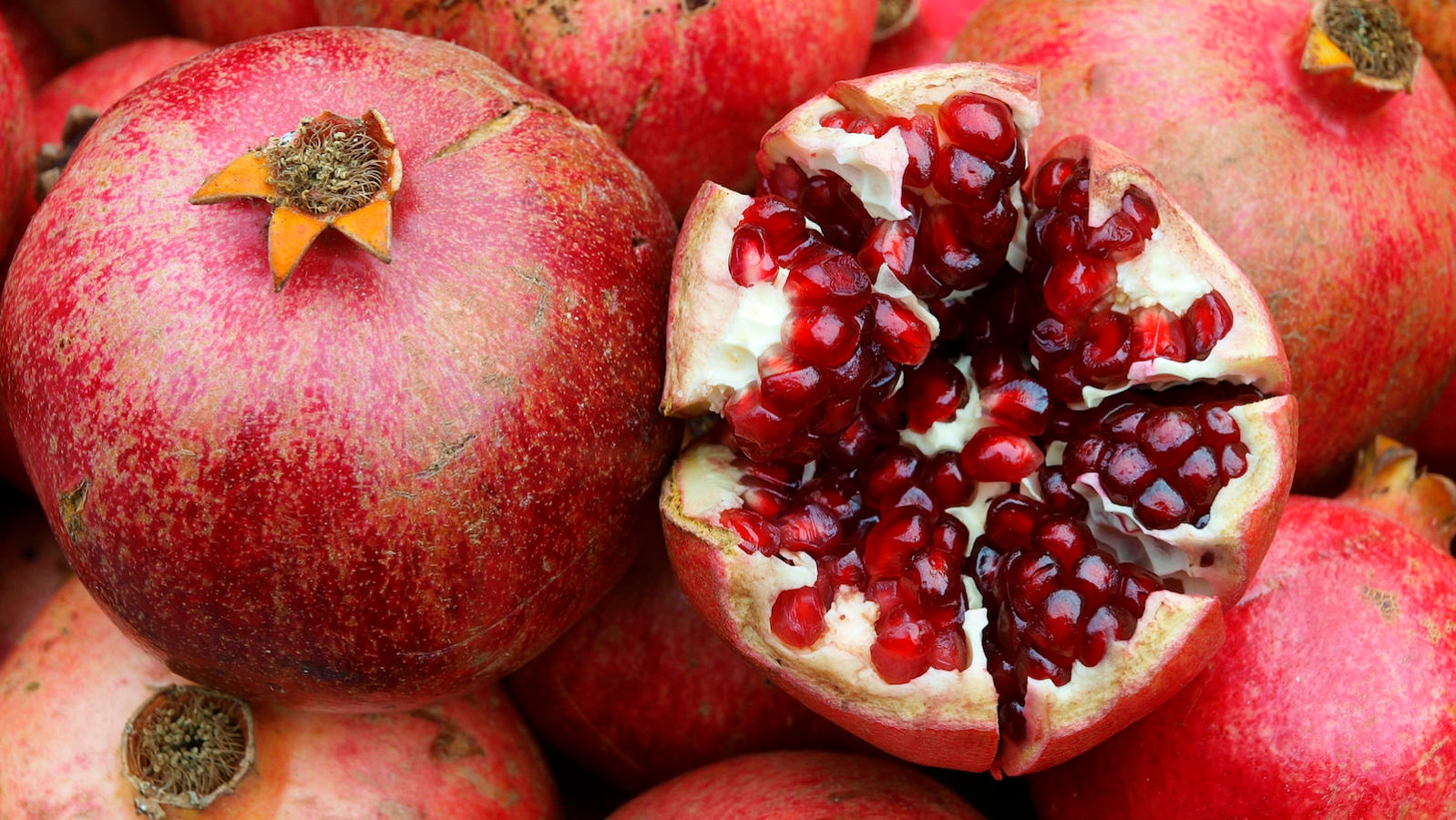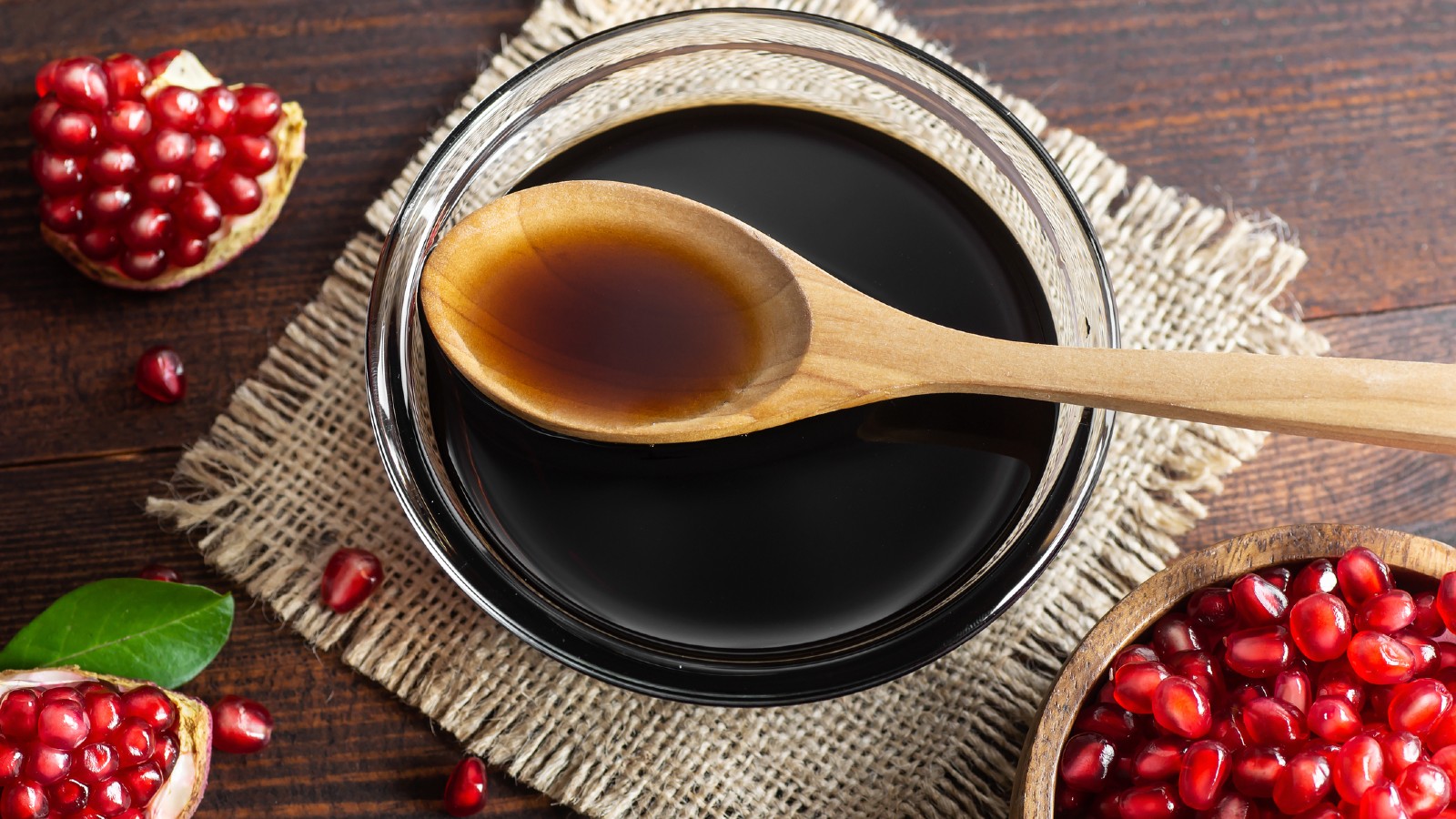Thick and slightly sweet, with cheek-puckering tartness, pomegranate molasses is a staple ingredient in Middle Eastern cuisine, where it was likely developed as a way to preserve a bumper crop of pomegranates. Pomegranate molasses plays a starring role in many Sephardic dishes, including fesenjan, a Persian chicken stew; muhammara, a red pepper spread from Syria; and batinjan bil rumman, a classic pairing of eggplant and pomegranate from Lebanon. In Israeli cuisine, pomegranate molasses lends zing to Israeli salads and balances the sweetness of the rosewater pudding, malabi.
Pomegranates, one of the Seven Species of Israel (along with wheat, barley, grapes, figs, olives and dates), have been a part of Jewish culture for thousands of years. They appear in countless Jewish stories and songs, on Judean coins and temples, and adorn Torah scrolls. The thick-skinned, seed-filled fruit, which is technically a berry, is a common sight on tables at Rosh Hashanah, when, on the second night, it’s typically consumed as a ‘new fruit.’ The many arils, or seeds, of the pomegranate are said to represent the 613 mitzvot, and a common Rosh Hashanah blessing dating back to the 14th century exclaims, “May our blessings proliferate like the [seeds of the] pomegranate.”

Technically speaking, pomegranate molasses isn’t molasses at all. The lip-smacking syrup is nothing more than a simple reduction, which means it’s something you can (and should) whip up in your own kitchen.
If you’re short on time, I’ve never had much trouble scoring the crimson syrup from international grocers, grocery stores or the internet. Cortas is a reliable brand with a deep rust-colored syrup that has a pleasant balance of sweetness and tartness. For an organic alternative, try Just Pomegranate Organic Syrup, which leans toward the tart side.
The Nosher celebrates the traditions and recipes that have brought Jews together for centuries. Donate today to keep The Nosher's stories and recipes accessible to all.
Though pomegranate molasses is a molasses in name only, you absolutely should swap out blackstrap molasses for pomegranate molasses in baking recipes. Doing so will result in baked goods that feature more nuance and pizzazz, thanks to the natural tartness of the pomegranate. There are a myriad of other ways to put this magical ingredient to good use:
Dress to Impress
Piquant and lively, pomegranate molasses was made for jazzing up salads. Yotam Ottolenghi’s Tomato and Pomegranate Salad combines pomegranate molasses and arils with tomatoes and peppers. And in this recipe for black eyed peas with turmeric and pomegranate, the molasses elevates the earthy beans.
Steal the Show
Few condiments can stand up to big, meaty flavors quite like pomegranate molasses, which balances the savory richness of a honking lamb shoulder, as in this recipe from Michael Solomonov. Or combine it with brown sugar to lend a little sweetness to a Rosh Hashanah chicken.
Sweet Tart
In this streusel-topped coffee cake recipe, pomegranate molasses bounces off the notes of cinnamon in a way that invites bite after bite (after bite), and in this pomegranate molasses butter cake, a deceptively simple pomegranate glaze elevates a humble one-layer cake into something downright extraordinary. Just a tablespoon of pomegranate molasses gives these date and pomegranate blondies a pink hue and a burst of brightness.
To make pomegranate molasses at home, while some recipes call for adding lemon juice or sugar — both of which act as flavor enhancers and preservatives — to pomegranate juice, all you really need for a tangy pomegranate molasses is juice and time.
Note: This lasts for months when stored in the fridge.
Pomegranate Molasses
All you really need for a tangy pomegranate molasses is juice and time. I find that making my own allows me to control the flavor and vibrancy of the final product.
- Total Time: 1 hour
- Yield: 1 cup
Ingredients
- 32 oz pomegranate juice (RW Knudsen or any brand without additional sweeteners, including Pom; or juice 6-8 pomegranates)
Instructions
- Bring a 32 oz pomegranate juice to a simmer, and simmer for about 1 hour until it coats the back of a spoon. (Keep an eye on it because if it goes too far, you’ll lose the essential anthocyanins — the pigment that gives pomegranates their bright pink flavor and astringent taste.)
Notes
Store in the fridge for months.
- Cook Time: 1 hour
- Category: Dessert
- Method: One-pot
- Cuisine: Vegan




Leave a Comment